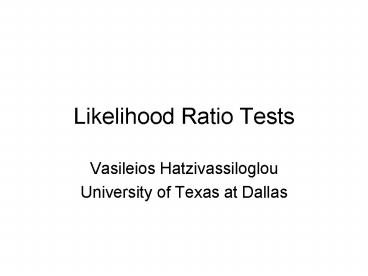Likelihood Ratio Tests - PowerPoint PPT Presentation
1 / 13
Title:
Likelihood Ratio Tests
Description:
Goodness-of-fit test. We can also apply Pearson's chi-square as a goodness-of-fit test ... Then the chi-square test can be used to determine if the corpora are similar ... – PowerPoint PPT presentation
Number of Views:30
Avg rating:3.0/5.0
Title: Likelihood Ratio Tests
1
Likelihood Ratio Tests
- Vasileios Hatzivassiloglou
- University of Texas at Dallas
2
Aligned French-English words
- Uses an aligned corpus at the sentence level
3
Chi-square test results
- X2 for new companies example 1.55
- X2 for vache cow example 456,400
- Critical values
- 3.84 for 5 significance
- 6.63 for 1 significance
- 10.83 for 0.1 significance
4
Goodness-of-fit test
- We can also apply Pearsons chi-square as a
goodness-of-fit test - X and Y are two random variables with the same
range of categorical values - Then we construct a 2n table (n is the number of
possible values) and compare if Xi and Yi have
similar values
5
Application corpus comparison
- We use as Xi and Yi the word counts of different
words i in two different corpora - Then the chi-square test can be used to determine
if the corpora are similar - We usually limit the words i to those with
reasonable overall frequency
6
Likelihood ratio tests
- The likelihood ratio of two hypotheses is the
ratio of the probabilities that we would have
seen the observed data under each of the
hypotheses
7
Likelihood ratio advantages
- It is interpretable directly as the odds in favor
of H1 versus H2 - It is a more robust statistic than ?2, and
therefore more reliable when the assumptions for
the chi-square test are not met (e.g., rare
events and low expected cell counts)
8
Likelihood ratio for association
- We are testing if two words w1 and w2 are
associated (e.g., in a collocation) - Hypothesis 1 No association
- P(w2 w1) P(w2 w1) p
- Hypothesis 2 Baseline / no assumption
- No particular relation between p1 P(w2 w1)
and p2 P(w2 w1)
9
Estimating the parameters
- We use maximum likelihood estimates
- Then
10
Calculating the likelihoods
- The distribution is binomial (with different
parameters in each case) - P(data) P(w2 after w1 data) P(w2 after w1
data) - We observed w2 after w1 c(w1w2) times out of
c(w1) - We observed w2 after something other than w1
c(w2)-c(w1w2) times out of N-c(w1) times
11
Component likelihoods
- Under hypothesis 1,
- P(w2 after w1 data) b(c12 c1, p)
- P(w2 after w1 data) b(c2-c12 N-c1, p)
- Under hypothesis 2,
- P(w2 after w1 data) b(c12 c1, p1)
- P(w2 after w1 data) b(c2-c12 N-c1, p2)
- where
12
Likelihood ratio formula
13
Reading
- Section 5.3.4 on log-likelihood tests






























